
|   |

|   |
Varying dance forms and themes at the World Dance Day 2022 - Dr. S.D. Desai e-mail: sureshmrudula@gmail.com Photos: Gopal Patel May 7, 2022 As part of its Golden Jubilee celebrations, Nartan Institute of Performing Arts, founded by veteran Kuchipudi and Bharatanatyam dancer Smita Shastri, who still dances, organized an evening of classical dance performances, both solo and group, by five of the many dance centres of Ahmedabad on the International Dance Day (29 April 2022) at the Lions Hall. The event gave a taste of Bharatanatyam, Kuchipudi, Kathak, Odissi and Contemporary dance styles. 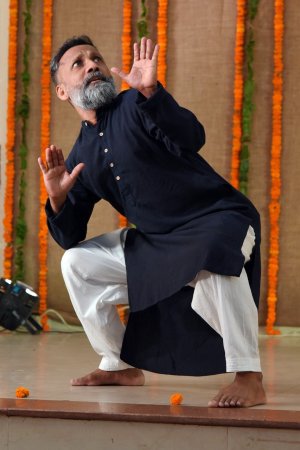 Padmakumar Though the programme took off with Bijal Haria's Ganapati Vandana in Kuchipudi, a customary invocation to Lord Ganesha in Raja Radha Reddy's choreography, a mention must be made initially, changing the sequence, to D Padmakumar's Vismaya in Vinita Jayan's choreography. A dainty presentation termed contemporary, it reminded everyone of what a classical dance entails. Drawing from his Kalaripayattu and Bharatanatyam skills, he demonstrated how like a tortoise the dancer, withdrawing from all distractions and conditioned sensory perceptions, turns so inward and steady that he can give responses as those generated by the first thrilling contact with the universe - his eyes, feet, hands, rather the whole body, greets its elements with freshening spontaneity. Much later, the concluding item of the entire programme was a duet-like smoothly fluid presentation of Kalari skills by Dhruval and Divya, Pappan's trainees. 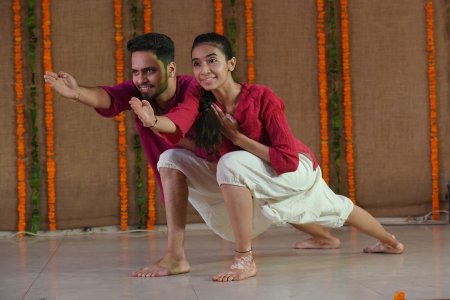 Dhruval and Divya Three solos gave an idea of our dancers' sources for their themes. Nartan's budding dancer Prashita turned to the traditional repertoire of Bharatanatyam for her Varnam. Choreographed by K Kalyanasundaram, it portrays three Krishna-centric episodes. In one, child Krishna in one of his famous pranks steals butter at home and invites mother Yashoda's mock fury. In another, he dives deep into sea waters, encounters and, following a one-to-one battle, overcomes the might of a ferocious Kaliya Nag. Her third episode was the affection he graciously showers on Sudama, a school-time friend now a poor householder. Jayan Nair supports the young dancer's engaging action with his music.  Bijal Haria (courtesy Bijal Haria) 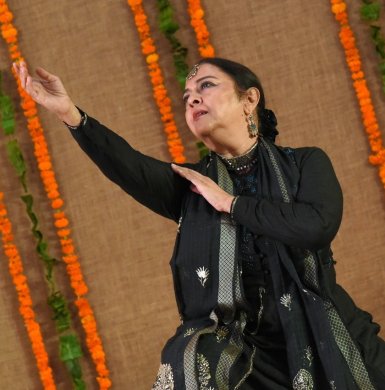 Vaishali Trivedi Founder of Parampara Academy having multiple art pursuits, Bijal Haria in her Bala Gopala Tarangam to misra chapu rhythm was a delight to watch. Based on Krishna Leela Tarangini and composed by saint-poet Tirth Narayan Yeti with child Krishna's pranks, it has the dancer in culminating moments dancing on the rim of a brass plate with bewitching bends of the body holding on the head a small pitcher and diyas in hands. Vaishali Trivedi, director of Sangati Centre and the most experienced among the performers at the event, chose to go to the Mahabharata for the Cheeraharana episode unfolded by Meera in her song tuma bina kaun in her own trained voice. A feeling of devotion was enhanced in Atul Desai's composition and the perennial significance of Draupadi's humiliation was underscored by Vaishali with suggestion in her Kathak solo.  Dhruva-Prashita An ancient dance drama with a spiritual content in the Kuchipudi style, another dance drama imaginatively created from a heritage site of architecture and sculpture in Odissi and a group dance based on an abstract theme in original choreography in Kathak was a welcome combination at the event celebrating the World Dance Day. Bhamakakalapam was done by a young but skilled group of dancers Dhruva (Krishna), Prashita (Satyabhama) and Venu, Jhanvi, Jasmine (sakhis). Satyabhama though beautiful and abounds in wealth gets vainglorious. Krishna, her divine spouse, helps her shed arrogance and be on the path of salvation with a positive attitude. Both Krishna and Satyabhama were brilliantly portrayed. 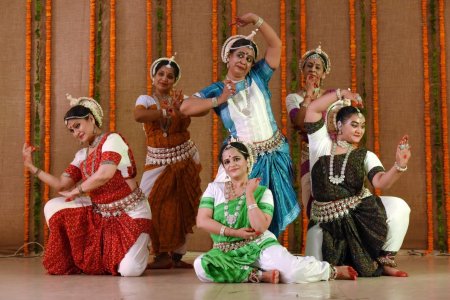 Rani ki Vav Even with varying skills of participating dancers, Aum Arts' Rani ki Vav grew into a good dance drama in relatively pleasing Odissi group formations done by its director Suprava Mishra, a researcher, writer and dancer. Based on her study and acquired skills of the dance form it connects her students (Falguni, Sucharita, Shikha and others led by Suprava) with the dancing apsaras and girls playing instruments like veena, bansuri, manjeera and mardala of the 11th century world heritage site near Patan in Gujarat. From the galleries forming part of the stepwell, they spring to life for the viewers and go back to them. In the choreographer's conceptualization, like the mother nourishes the unborn with fluid, the stepwell water sustains the life of a traveller. In Sangati's Kathak Tarana, all its elements - music (Ramesh Bapodara), movement and expression (choreographed by Vaishali Trivedi), costume designs (Shimul) delightfully blended. In this form, there are no words, no narrative. It is the musical ambience and rhythm that prompt exhilarating movements and intricate mudras in a variety of patterns with the dancers' faces radiating a joyous glow (Salomi, Kalrav, Amira, Vaama) and create a rasanubhava the audience partakes of. Earlier, Sangati had a pleasing duet presentation with Salomi and Kalrav as dancers with complementary movement and abhivyakti. 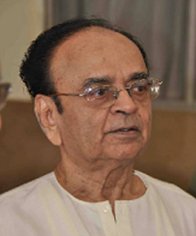 Dr. S.D. Desai, a professor of English, has been a Performing Arts Critic for many years. Among the dance journals he has contributed to are Narthaki, Sruti, Nartanam and Attendance. His books have been published by Gujarat Sahitya Academy, Oxford University Press and Rupa. After 30 years with a national English daily, he is now a freelance art writer. |